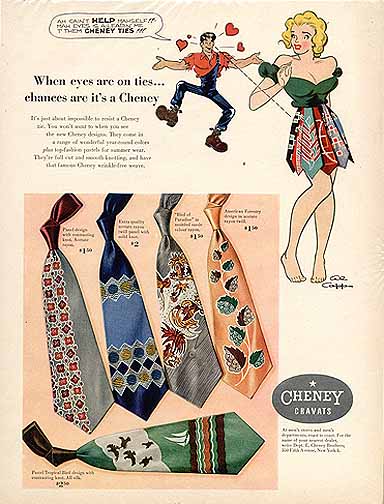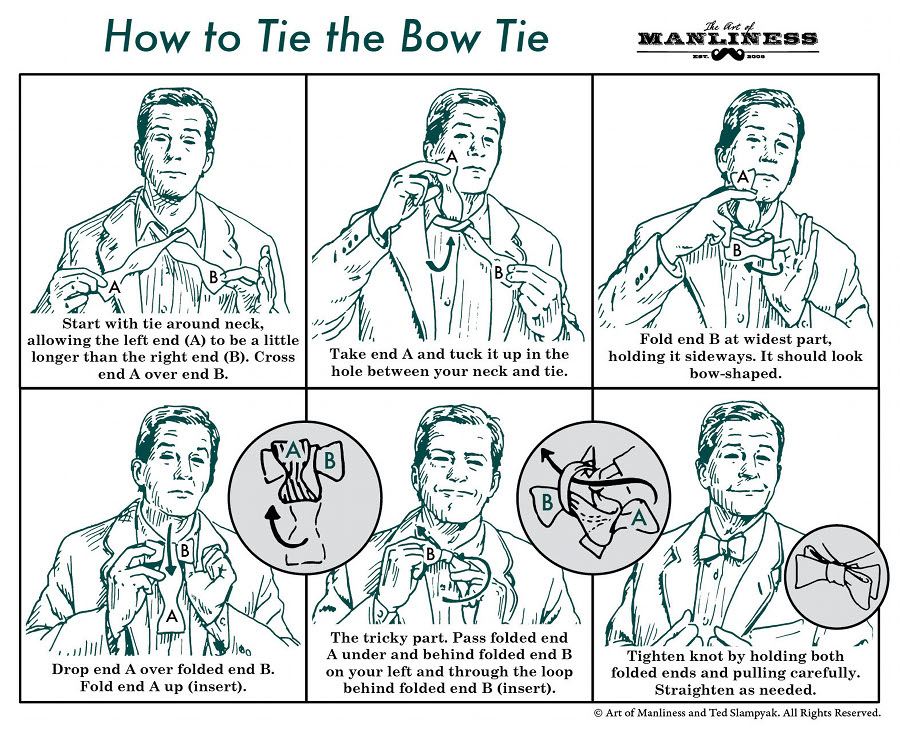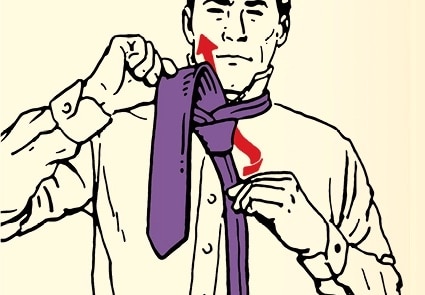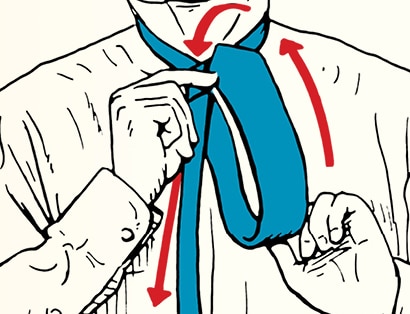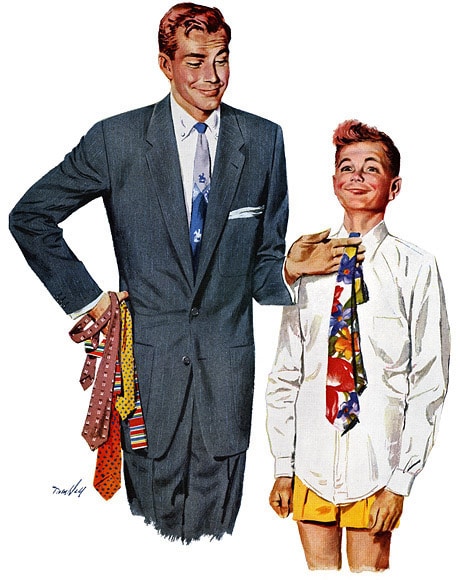
Men’s magazine writers and cultural observers have been predicting the demise of the necktie for nearly a century now. Way back in 1921, the Associated Press reported: “Neckties Doomed.” Flip through archival issues of Esquire, and you’ll find at least one article in each decade of the 20th century prophesying the death of this sartorial accessory.
But these obituaries were premature; the necktie kept on beating the odds.
In fact, sales of ties increased in the late 2000s and early ‘10s. For a while there, the tie wasn’t just surviving — it was thriving.
Then, the pandemic happened. The world shut down. Men started working from home. Instead of putting on a dress shirt and tie, they could put on a t-shirt and hoodie. If they needed to appear presentable for a Zoom meeting, they’d throw on a dress shirt, with naked, unadorned collar, and call it good.
Most in-person events were canceled too. Goodbye to nice dinners. Goodbye to swanky weddings.
As the work-from-home, recreate-from-home era dawned, comfort and informality took the field, while formality and dressed-up style were temporarily sidelined.
I say “temporarily” because I think there was, at least at first, an unspoken assumption that once the gears of “normal” life fully started up again, the tie would make a comeback. After all, that’s just what you’re supposed to wear when you work at a respectable office or show up to a classy shindig.
But will the necktie really make a return? Or has the pandemic accelerated an already extant trend towards sartorial informality, making men increasingly intolerant of any get-ups that don’t allow for an elasticized waistband and putting the necktie, at long last, on its final silky legs?
I reached out to six menswear writers to get their takes. Here’s what they had to say as to what the future of the necktie holds.
Tanner Guzy is a men’s style coach and the author of The Appearance of Power: How Masculinity Is Expressed Through Aesthetics.
“Five years ago I would’ve told you it would take a major cultural revolution to fully and effectively kill off the tie — the kind of revolution that really only comes with war or major regime changes. But now that we’ve been through COVID and seen most white-collar environments — the only ones that still really require a tie — move to remote work and a more casual aesthetic, I think we’re nearing the end of its ubiquity.
Which isn’t to say we won’t still see men wearing ties — there will be certain professions or scenarios in which it will still be both appropriate and expected — lawyers in a courtroom, politicians giving speeches, etc. But, just like we saw the tie and collared shirt stop being standard in the blue-collar world, I project we’re near the end of it being a normal part of white-collar environments as well.”
David Coggins is the author of several books, including Men and Style, and regularly writes about culture and menswear in his newsletter The Contender.
“For a relatively small piece of fabric, the tie receives a lot of attention. That’s because it’s the easiest barometer of formality. If an event requires a tie then that tells you something. As we know, there are fewer and fewer places that ask for a tie. I think that will mean that the people who wear them will wear them by choice, not by default. So a tie, and a suit for that matter, will not indicate a depressed middle manager, but a more dynamic sense of expression. At least that’s my hope anyway. I still hold out hope for a few bands of well-dressed iconoclasts.”
Russell Smith is a writer and the author of The Thinking Man’s Guide to Style.
“For the first two weeks of August I watched coverage of the Olympics on the CBC, Canada’s national broadcaster. One of the two anchors was a well-dressed guy called Andrew Chang, who is also one of the anchors of the national nightly TV news. Throughout the coverage he wore an elegant, tailored three-piece suit, shiny shoes, and cufflinks.
And no tie.
This struck me as obviously incongruent: the suit — especially the suit with a waistcoat — called out for a tie. It looked as if he had simply rushed out before finishing dressing. I could see maybe a sports jacket with no tie, or a casual, less constructed suit, with maybe suede shoes, and no tie, but this just looked wrong. However, I am sure it was a conscious decision made by highly-paid stylists who had obviously decided that ties were out, even with the most formal of suits. Maybe they had been listening to all the interviews with men’s clothing store owners who are desperate to get people back into their stores and are promising that there will be plenty of casual wear on offer so as not to scare people off. So maybe this will be a new look. But I think not.
Personally, I think that they are wrong about the public mood — after so many months of dull clothes, when office work returns, people will be eager to indulge the sensual and theatrical side of personal style again, and will bring their beautiful ties out of the closet with a great sense of relief. We all miss nice clothes.”
Antonio Centeno is the founder of Real Men Real Style and a popular menswear YouTuber who has contributed many an article to AoM’s own style archives.
“The necktie has been a men’s wardrobe staple for 400 years. Its historical purpose has always been to support the more prominent garments, jackets and more recently dress shirts, by introducing interchangeable color to an outfit. Functionally, it also helps to bring the collar together and draw attention to the wearer’s face.
Over the last twenty years, workplaces have relaxed their dress codes, and we’ve witnessed the rise of athletic-leisure as a style in itself. All of this seems to indicate that the necktie is obsolete and near extinction. My take, however, is that this is just a swing of the fashion pendulum.
Human beings, as social creatures, defer to visual cues to determine rank and status among strangers. For this reason alone the necktie will survive, as no other accessory so prominently sends the message of professionalism as a well-tied necktie. The wearing of neckwear as a symbol and tool will be with us until we no longer have necks to adorn.”
Joe Weber is the owner of Dappered, a blog that highlights affordable men’s clothing for the average dude.
“I think there’s a real chance that while neckties will be seen less and less in all but the most conservative workplaces, they could very well become a new status symbol. While those in middle management who begrudgingly wore a tie will now ditch them, those at the top will still wear them. Neckties will still be worn by those in charge, especially when they need to take charge. Why? Neckties are a lot like suits and dress shoes. They’re items of clothing that have evolved over time to project competence and power. The world of professional soccer is a perfect showcase for this hierarchy. The head coach is often in a coat and tie (especially for a big game), while his assistants are all in tracksuits (read: athleisure). He’s the boss. And everyone knows it.
Yet even if you’re not at the top of a corporate food chain, you should still own and wear a couple of good neckties. Because one day you’ll need to wear one. And if you’re not used to something, it’ll show. You’ll be uncomfortable, and that will totally negate the intended purpose of the suit, the shoes, and/or the tie. Practice. Even if you don’t have to. Just do it. Because when things get big (wedding, appearing in court, aliens have landed), not just wearing the uniform of competence, but also looking at ease in it, can make all the difference. I’m not saying it’s fair. It probably isn’t fair. I’m just saying it is.”
Sven Raphael Schneider and Preston R. Schlueter are, respectively, the founder and content director of The Gentleman’s Gazette, a website and YouTube channel that specializes in classic menswear.
“WWI and WWII, major global events, casualized menswear — so it’s fair to ask, will the COVID-19 pandemic have the same effect, especially on the tie? Either by mandate or by choice, fewer men are attending the office or social events today, and thus have less occasion to wear a tie. Remember, though, that WWI was followed by the Roaring Twenties, wherein people savored the opportunity to dress up and enjoy themselves after a dark chapter in human history. And while prosperity following WWII was less universal, Americans certainly displayed a renewed appetite for consumption and entertainment in the 1950s.
We believe that in the years and decades following COVID-19, fewer men will wear ties overall, simply because they won’t be forced to, and because many will find it uncomfortable. At the same time, thanks to the internet, clothing enthusiasts can now educate themselves much more easily than they could 50 years ago, and can readily find like-minded peers. Because of these factors, we believe that a certain niche group of men will embrace the tie, and wear it not because they have to, but because they choose to.
In a similar fashion to how devoted subgroups of men uphold the traditions of “hat culture” with their fedoras and flat caps, and to how the suit is shedding its reputation as a symbol of corporate conformity to be a canvas for personal expression, the tie will be kept alive by enthusiastic wearers.”



